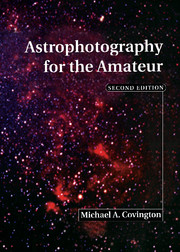Book contents
- Frontmatter
- Dedication
- Contents
- Preface
- Notes to the reader
- Symbols usued in formulae
- I SIMPLE TECHNIQUES
- 1 Welcome to astrophotography
- 2 Photographing stars without a telescope
- 3 Comets, meteors, aurorae, and space dust
- 4 The moon
- 5 Eclipses
- II ADVANCED TECHNIQUES
- III PHOTOGRAPHIC TECHNOLOGY
- IV DIGITAL IMAGING
- APPENDICES
1 - Welcome to astrophotography
Published online by Cambridge University Press: 05 September 2013
- Frontmatter
- Dedication
- Contents
- Preface
- Notes to the reader
- Symbols usued in formulae
- I SIMPLE TECHNIQUES
- 1 Welcome to astrophotography
- 2 Photographing stars without a telescope
- 3 Comets, meteors, aurorae, and space dust
- 4 The moon
- 5 Eclipses
- II ADVANCED TECHNIQUES
- III PHOTOGRAPHIC TECHNOLOGY
- IV DIGITAL IMAGING
- APPENDICES
Summary
Welcome to astrophotography! This book is for people who want to take pictures of the stars and planets, and, perhaps more importantly, who want to understand how astrophotography works. The earlier chapters contain instructions for beginners, and the later chapters are more like a reference book.
My goal is to show you how to do astrophotography at modest cost, with the equipment and materials an amateur can easily obtain and use. I haven't covered everything. I've concentrated on 35-mm cameras and relatively inexpensive telescopes, 20-cm (8-inch) and smaller. Techniques that require unusual skill or expenditure are mentioned only briefly with references to other sources of information.
The challenge of astrophotography
Why photograph the sky? Because of the great natural beauty of celestial objects, because your pictures can have scientific value, and, perhaps most importantly, because you enjoy the technical challenge. Astrophotography will never be a matter of just taking snapshots, and Kodak's old slogan, “You press the button, we do the rest,” certainly doesn't apply. Astrophotographers push the limits of their equipment and materials, and a good astrophotographer has to know optics and film the way a race-car driver knows engines. There are three main technical challenges:
Most celestial objects require magnification; that's one reason we use telescopes. (Not all objects require magnification; star fields, meteors, and bright comets can be photographed with your camera's normal lens.)
Many celestial objects are faint, requiring long exposures to accumulate light on the film. In fact, astronomical discoveries have been made this way; the Horsehead Nebula and Barnard's Loop are too faint to see with any telescope, but are not too hard to photograph.
[…]
- Type
- Chapter
- Information
- Astrophotography for the Amateur , pp. 3 - 7Publisher: Cambridge University PressPrint publication year: 1999



